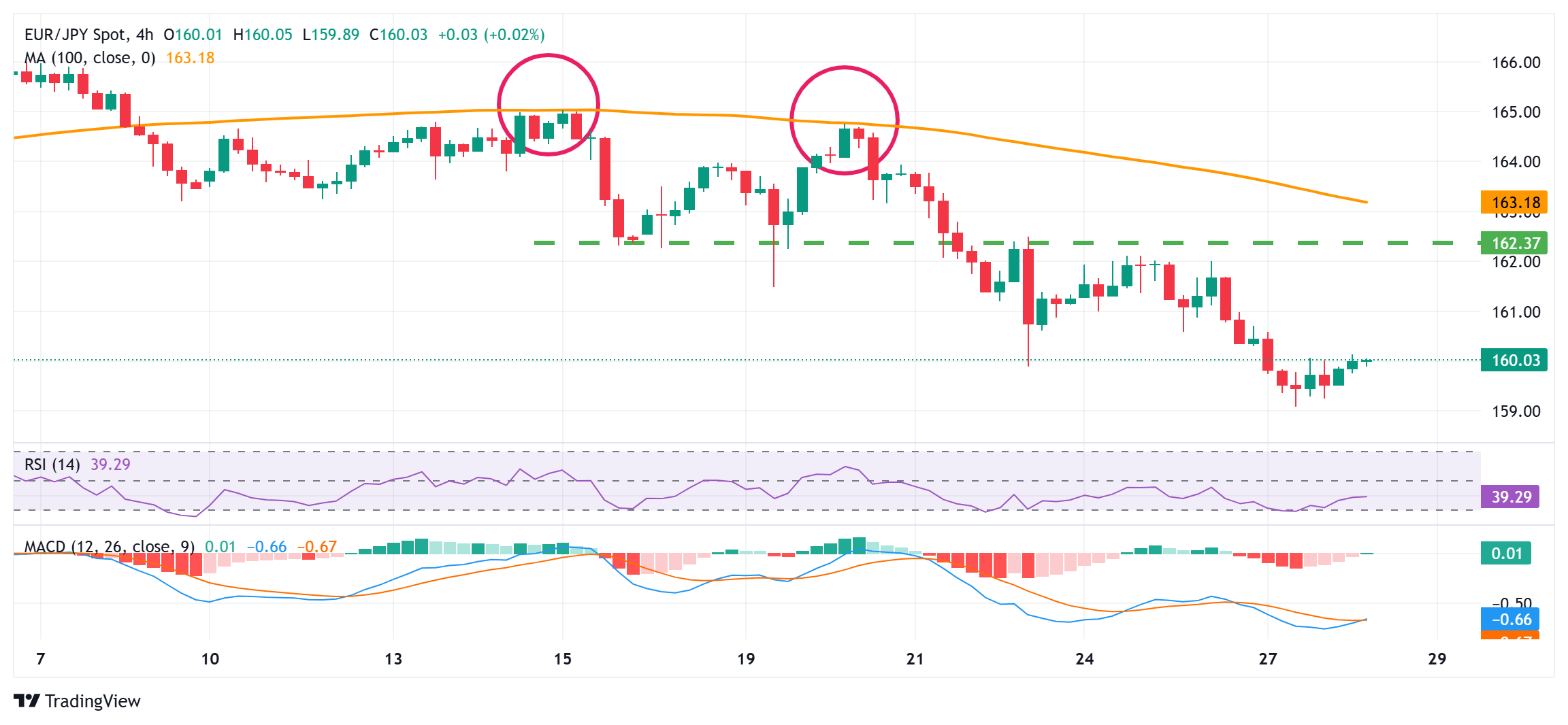- EUR/JPY recovers from a multi-month low amid the emergence of some selling around the JPY.
- Bets for a December BoJ rate hike, trade war fears and geopolitical risks could limit JPY losses.
- The setup supports prospects for the emergence of fresh selling around the cross at higher levels.
The EUR/JPY cross gains some positive traction during the Asian session on Thursday and moves away from its lowest level since early October, around the 159.10 region touched the previous day. The intraday uptick lifts spot prices to the 160.00 psychological mark in the last hour and is sponsored by the emergence of fresh selling around the Japanese Yen (JPY).
Any meaningful JPY depreciation, however, seems elusive in the wake of speculations that the Bank of Japan (BoJ) will hike interest rates again in December. Apart from this, US President-elect Donald Trump's tariff threats and geopolitical risks might continue to benefit the safe-haven JPY. This, along with bets for faster interest rate cuts from the European Central Bank (ECB), should act as a headwind for the shared currency and cap the EUR/JPY cross.
From a technical perspective, the recent repeated failures near the 100-period Simple Moving Average (SMA) on the 4-hour chart and a subsequent breakdown below the 162.35-162.30 support favor bearish traders. Moreover, oscillators on the daily chart are holding deep in negative territory and are still away from being in the oversold zone. This suggests that any subsequent move up in the EUR/JPY cross could be seen as a selling opportunity and remain limited.
In the meantime, the overnight swing high, around the 160.70 area, is likely to act as an immediate hurdle ahead of the 161.00 mark. Some follow-through buying beyond the 161.30 region might trigger a short-covering rally and allow the EUR/JPY ross to reclaim the 162.00 round figure. The momentum, however, runs the risk of fizzling out rather quickly near the 162.30-162.35 region, which now seems to act as a key pivotal point for short-term traders.
On the flip side, the Asian session low, around the 159.45 area, could protect the immediate downside ahead of the 159.10-159.05 region, or the multi-month low set on Wednesday. A sustained break below the 159.00 mark will be seen as a fresh trigger for bearish traders and drag the EUR/JPY cross to the 158.55 zone en route to the late September swing low, around the 158.00 mark and the next relevant support near the 157.65 region.
EUR/JPY 4-hour chart
Japanese Yen FAQs
The Japanese Yen (JPY) is one of the world’s most traded currencies. Its value is broadly determined by the performance of the Japanese economy, but more specifically by the Bank of Japan’s policy, the differential between Japanese and US bond yields, or risk sentiment among traders, among other factors.
One of the Bank of Japan’s mandates is currency control, so its moves are key for the Yen. The BoJ has directly intervened in currency markets sometimes, generally to lower the value of the Yen, although it refrains from doing it often due to political concerns of its main trading partners. The BoJ ultra-loose monetary policy between 2013 and 2024 caused the Yen to depreciate against its main currency peers due to an increasing policy divergence between the Bank of Japan and other main central banks. More recently, the gradually unwinding of this ultra-loose policy has given some support to the Yen.
Over the last decade, the BoJ’s stance of sticking to ultra-loose monetary policy has led to a widening policy divergence with other central banks, particularly with the US Federal Reserve. This supported a widening of the differential between the 10-year US and Japanese bonds, which favored the US Dollar against the Japanese Yen. The BoJ decision in 2024 to gradually abandon the ultra-loose policy, coupled with interest-rate cuts in other major central banks, is narrowing this differential.
The Japanese Yen is often seen as a safe-haven investment. This means that in times of market stress, investors are more likely to put their money in the Japanese currency due to its supposed reliability and stability. Turbulent times are likely to strengthen the Yen’s value against other currencies seen as more risky to invest in.
Information on these pages contains forward-looking statements that involve risks and uncertainties. Markets and instruments profiled on this page are for informational purposes only and should not in any way come across as a recommendation to buy or sell in these assets. You should do your own thorough research before making any investment decisions. FXStreet does not in any way guarantee that this information is free from mistakes, errors, or material misstatements. It also does not guarantee that this information is of a timely nature. Investing in Open Markets involves a great deal of risk, including the loss of all or a portion of your investment, as well as emotional distress. All risks, losses and costs associated with investing, including total loss of principal, are your responsibility. The views and opinions expressed in this article are those of the authors and do not necessarily reflect the official policy or position of FXStreet nor its advertisers. The author will not be held responsible for information that is found at the end of links posted on this page.
If not otherwise explicitly mentioned in the body of the article, at the time of writing, the author has no position in any stock mentioned in this article and no business relationship with any company mentioned. The author has not received compensation for writing this article, other than from FXStreet.
FXStreet and the author do not provide personalized recommendations. The author makes no representations as to the accuracy, completeness, or suitability of this information. FXStreet and the author will not be liable for any errors, omissions or any losses, injuries or damages arising from this information and its display or use. Errors and omissions excepted.
The author and FXStreet are not registered investment advisors and nothing in this article is intended to be investment advice.
Recommended content
Editors’ Picks

EUR/USD keeps the red near 1.0550 ahead of German inflation data
EUR/USD holds losses near 1.0550 in the European morning on Thursday. The pair's downside could be attributed to French political worries and a broad US Dollar rebound amid the cautious mood. Traders remain wary due to mounting trade war risks. Germany's inflation data is in focus.

GBP/USD holds lower ground near 1.2650
GBP/USD remains pressured near 1.2600 in European trading on Thursday as the US Dollar picks up haven dmeand on deteriorating risk sentiment. A sense of cautiom prevails amid Trump's tariff plans even though liquidity remains thin on Thanksgiving Day.

Gold price stays defensive below $2,640 amid reviving US Dollar demand
Gold price reverts toward the weekly low of $2,605 in the early European session on Thanksgiving Thursday, snapping a two-day recovery. The US Dollar (USD) and the US Treasury bond yields breathe a sigh of relief, exerting downward pressure on the Gold price amid holiday-thinned trading conditions.

Fantom bulls eye yearly high as BTC rebounds
Fantom (FTM) continued its rally and rallied 8% until Thursday, trading above $1.09 after 43% gains in the previous week. Like FTM, most altcoins have continued the rally as Bitcoin (BTC) recovers from its recent pullback this week.

Eurozone PMI sounds the alarm about growth once more
The composite PMI dropped from 50 to 48.1, once more stressing growth concerns for the eurozone. Hard data has actually come in better than expected recently – so ahead of the December meeting, the ECB has to figure out whether this is the PMI crying wolf or whether it should take this signal seriously. We think it’s the latter.

Best Forex Brokers with Low Spreads
VERIFIED Low spreads are crucial for reducing trading costs. Explore top Forex brokers offering competitive spreads and high leverage. Compare options for EUR/USD, GBP/USD, USD/JPY, and Gold.
